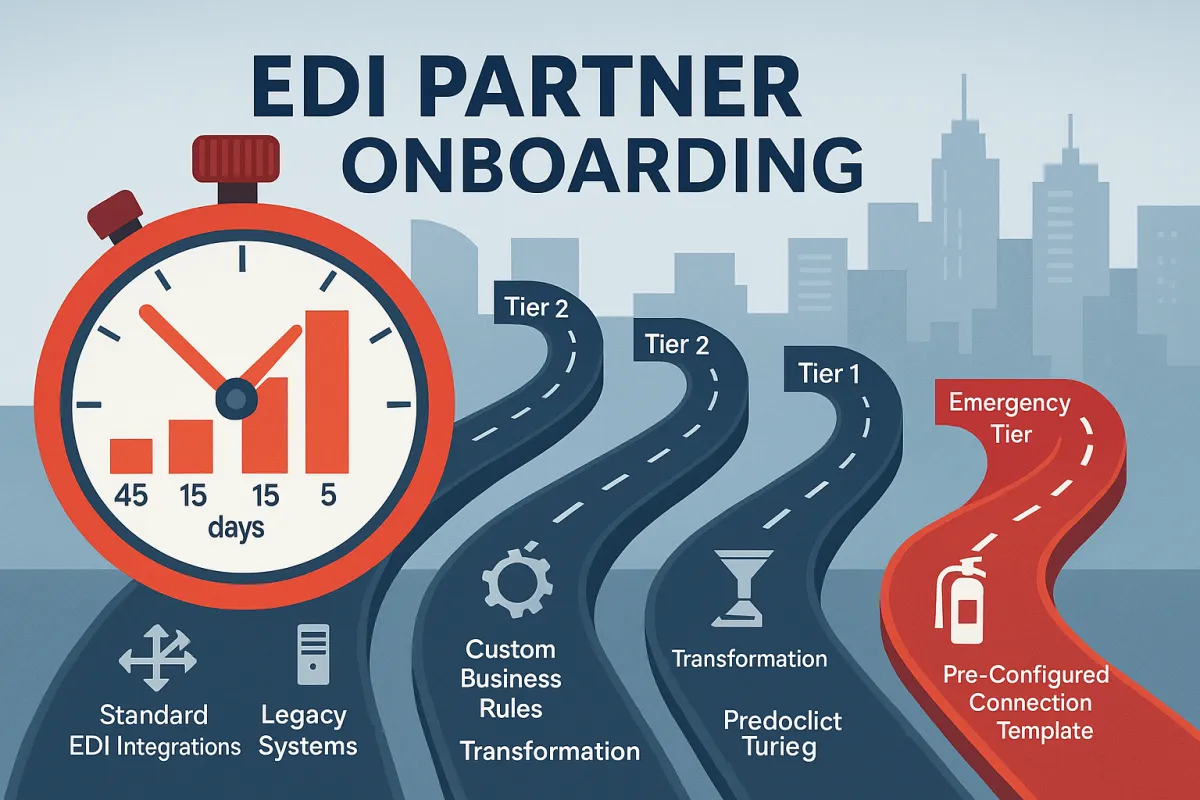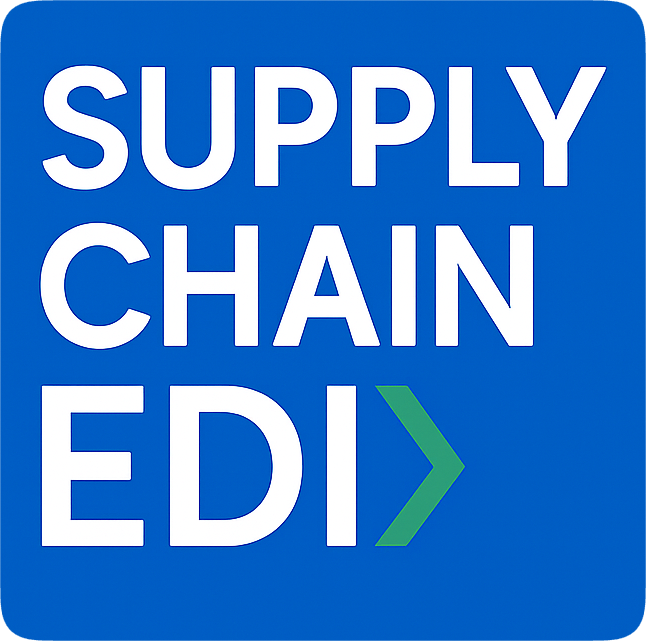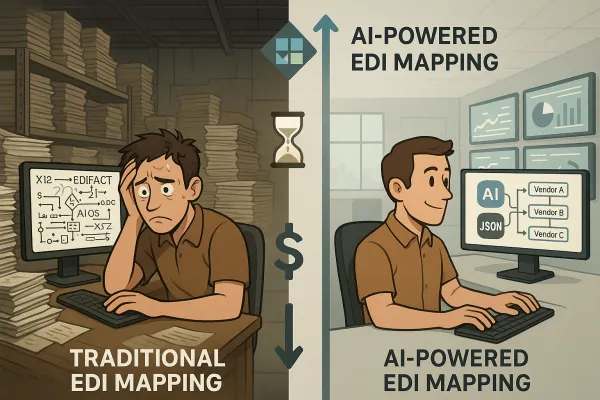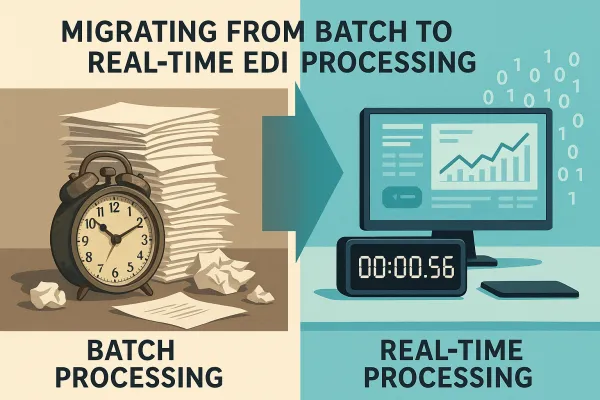The Strategic EDI Partner Onboarding Framework: Cut Integration Time from Months to Days While Ensuring 100% Compliance in 2025

Nearly half of IT managers report that slow EDI supplier onboarding is currently keeping their businesses from capturing new revenue opportunities. Yet most companies continue accepting 8-10 week EDI onboarding times. They don't try to streamline the process because they think it has to be this way—but they're wrong.
The stakes keep climbing. Nearly a quarter of companies (24%) are losing $500K or more to integration issues related to their supply chains. Meanwhile, large retailers like Walmart now demand new trading partners adopt and implement EDI as the base price of entry to do business, creating pressure for faster onboarding without sacrificing quality.
What if I told you there's a proven framework that cuts EDI partner onboarding from months to days while maintaining 100% compliance? Companies using this approach report 80% time reductions and dramatically improved partner satisfaction scores.
The Real Cost of Traditional EDI Onboarding
Let's get specific about what slow onboarding actually costs your business. Research by Ovum indicates that 53% of enterprises experience limitations with their current B2B integration solutions when it comes to rapidly onboarding trading partners. Additionally, the study highlights that approximately 40% of enterprises require over 30 days to onboard a new trading partner, adversely impacting business operations.
The traditional six-step EDI onboarding process reveals why these delays persist:
- Requirements gathering and documentation review
- Partner profile setup and testing environment configuration
- Data mapping and transformation development
- Integration testing cycles (often requiring coordination across time zones)
- User acceptance testing and validation
- Production deployment and monitoring setup
This is the most time intensive part of EDI onboarding. The challenge multiplies when you consider that every single EDI trading partner is going to have different requirements when it comes to onboarding. Some may require EDI documents to be sent in specific increments or even within a set time window.
Here's what makes this particularly painful: EDI onboarding is driven by humans, which includes back and forth feedback loops that aren't in real time. This results in wasted time and delays.
Breaking Down the Bottlenecks
Clearly one of the biggest challenges businesses have with successfully executing an EDI strategy is the onboarding of new trading partners. This challenge appears regardless of network or affiliation and whether the solution is an everything-to-everyone VAN or a simple service.
The root causes create a perfect storm of inefficiency:
Manual Configuration Overhead: One of the most significant challenges in implementing EDI transactions is the slow onboarding process for new partners. Traditional EDI systems often require extensive manual configurations, leading to prolonged setup times.
Testing Complexity: Most EDI tools do not validate your data against those guidelines. If validation is available, it simply compares the generated EDI file to generic EDI specification, which does not take into consideration the uniqueness of your trading partners guidelines.
Resource Constraints: Resource limitations, including staffing, time, or budget constraints, can impede the successful onboarding of EDI. However, effective planning, proper budgeting, and seeking external expertise can help businesses navigate these challenges and ensure a smooth implementation process.
Don't underestimate the partner experience challenge either. The complexity multiplies when dealing with suppliers who have limited EDI experience. Don't underestimate the challenge of onboarding a supplier with little experience using EDI. These partners often require extensive hand-holding, multiple test cycles, and additional validation steps.
The Strategic EDI Partner Onboarding Framework
The breakthrough approach involves implementing a tiered onboarding system that matches complexity with timeline expectations. Establish a tiered onboarding process: Tier 1 for simple, standard connections (target: 5 days), Tier 2 for moderate customization (15 days), and Tier 3 for complex, multi-system integrations (45 days maximum).
Here's how the framework works in practice:
Tier 1 - Standard Connections (5 Days): Partners using common EDI standards with minimal customization requirements. These leverage pre-built templates and automated mapping tools.
Tier 2 - Moderate Customization (15 Days): Partners requiring specific data transformations or custom business rules but following standard communication protocols.
Tier 3 - Complex Integrations (45 Days Maximum): Multi-system integrations, legacy system connections, or highly customized requirements that need extensive testing.
Emergency Tier (24-48 Hours): Critical business needs using pre-configured connection templates for immediate partner activation.
The key differentiator? This framework leverages modern technology stacks that weren't available during traditional EDI implementations. Deploy self-service onboarding portals that allow partners to configure basic connection parameters themselves. Solutions like nShift, Transporeon, and Cargoson offer pre-built connectors to major shipping carriers, reducing onboarding time from weeks to hours for common logistics partners.
Technology Enablers: AI, Cloud, and Automation in 2025
One of the most significant shifts in 2025 is the widespread adoption of cloud-based EDI solutions. Traditional on-premise systems are giving way to scalable, subscription-based platforms that offer: Lower upfront costs and reduced IT overhead. Faster onboarding of trading partners.
AI-powered automation represents the biggest game changer. Automation powered by AI can manage complex tasks—such as data mapping and validation—without human intervention, resulting in faster turnaround and lower operational costs. This facilitates smoother onboarding of new business partners and quicker adaptation to regulatory changes.
The AI capabilities delivering real results include:
Intelligent Data Mapping: One of the biggest challenges in traditional EDI is data mapping—the process of converting one data structure into another. AI and machine learning algorithms can automatically map data between EDI and ERP systems and other back-end applications like Shopify or WMS. AI-powered tools analyze historical data mappings and learn patterns to automate future mappings.
Automated Error Resolution: Intelligent error resolution uses AI to surface errors and provide recommended resolution paths – reducing the time to identify, investigate, and resolve issues.
Predictive Partner Support: Assisting suppliers and customers in navigating EDI requirements without needing human intervention. Businesses can use AI chatbots to guide partners through onboarding, compliance requirements, and troubleshooting.
Modern cloud platforms enable these capabilities at scale. A centralized solution allows enterprises to automate EDI onboarding flows and EDI transformation because it comes pre-loaded with B2B connectors that provide a repository of hundreds of pre-configured, ready-to-deploy communication templates to major trading partners in the supply chain.
Maintaining Compliance While Accelerating Speed
Speed without compliance creates bigger problems than slow onboarding. The 2025 regulatory landscape demands stronger security measures and data protection protocols.
With cyber threats on the rise, security is a top priority for EDI providers and users alike. Modern EDI systems now incorporate: End-to-end encryption for data in transit and at rest. Multi-factor authentication (MFA) for user access. Compliance with global standards like GDPR and ISO 27001.
The compliance-first approach requires:
Automated Validation: Use automated tools to map EDI documents to internal formats and validate data for accuracy, minimizing errors.
Real-time Monitoring: Set up real-time monitoring for failed transmissions, latency, or compliance issues. Dashboards and alerts help resolve issues quickly.
Comprehensive Testing: Use sandbox environments to test integrations with trading partners before going live, ensuring compatibility and reliability.
Documentation becomes critical here. Every accelerated onboarding must maintain audit trails and compliance documentation that meet industry standards and regulatory requirements.
90-Day Implementation Roadmap
Here's the practical transformation plan that companies use to implement this framework:
Weeks 1-2: Current State Assessment
- Audit existing partner onboarding processes and timelines
- Categorize current partners by complexity tier
- Identify technology gaps and integration requirements
- Establish baseline metrics for time, cost, and error rates
Weeks 3-6: Infrastructure Setup
- Select and deploy cloud-based EDI platform with AI capabilities
- Configure self-service partner portals
- Establish automated testing environments
- Create template libraries for each onboarding tier
Weeks 7-10: Pilot Testing
- Run pilot onboarding with 3-5 partners per tier
- Refine processes based on feedback and results
- Train internal teams on new workflows
- Document standard operating procedures
Weeks 11-12: Full Deployment
- Roll out framework to all new partner onboarding
- Migrate existing partners to optimized processes
- Implement continuous monitoring and improvement
- Establish success metrics and reporting
The key success factor? Change management and team alignment. Companies can support this by tooling, which requires well-defined processes, coordination across different collaboration tools, and skilled resources to ensure successful partner activation, onboarding and management.
Measuring Success: KPIs and ROI Metrics
Companies implementing this framework track specific metrics that demonstrate both operational improvements and business impact:
Time-to-Production: Average days from partner contract signing to live EDI transactions. Target reductions of 60-80% from baseline.
Error Rate Reduction: Percentage of failed or rejected transactions during initial partner testing and production rollout.
Partner Satisfaction Scores: Survey feedback on onboarding experience complexity, timeline expectations, and support quality.
Cost per Onboarding: Total internal and external resources required per partner, including system costs, staff time, and external support.
Revenue Impact: Faster partner activation leads to earlier transaction volumes and reduced opportunity costs from delayed partnerships.
One company tracked these results: "Our costs and efficiencies have resulted in an average ROI of $5,000 a month, and having direct access to the map and communication means we spend less time troubleshooting EDI issues. Client satisfaction has also increased, as there are fewer problems with our in-house EDI connections, and our time to resolve and respond to our customers when issues arise has decreased by at least 60 percent."
The transformation delivers measurable competitive advantages. Companies that reduce EDI onboarding time can adapt quickly to demand shifts and establish a competitive edge that builds with each new connection.
Your next step? Start with a current state assessment of your existing onboarding processes. Identify which partners fall into each complexity tier, then begin implementing the technology and process changes that will transform your EDI partner onboarding from a months-long bottleneck into a strategic competitive advantage.





